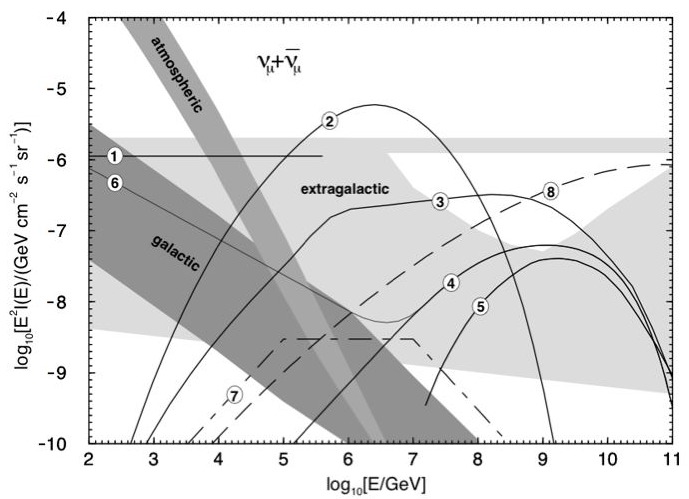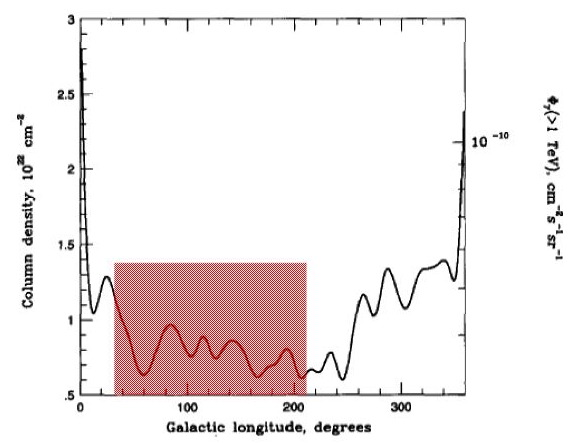John Kelley, UW-Madison, May 2005
![]()
Interactions of cosmic rays with the galactic interstellar medium are expected
to produce a flux of neutrinos from the galactic disk. Because of the low density
of the interstellar medium (approximately 1 particle / cm^3), the resulting
hadrons generally decay before interacting, and thus the spectrum of the neutrinos
produced should follow the cosmic ray spectrum — a power law of index
-2.7 up to knee energies. See Learned
& Mannheim, Annu. Rev. Nucl. Part.Sci.2000.50 for a nice overview.
The following figure from the Learned & Mannheim review paper shows one possible flux of muon neutrinos from the plane:

Figure 1.1: Galactic plane neutrino flux predictions (wide dark
gray band)
(figure from Learned & Mannheim)
The flux shown is derived from a model by Ingelman & Thunman (hep-ph/9604286). This and other models (such as Berezinsky et al.) calculate a flux which is linearly dependent on the column density of the galaxy in a particular direction. The upper bound of the predicted flux is from the direction of the galactic center (the highest column density), while the lower bound is from the direction of the galactic poles (the lowest column density). The flux from the outer galaxy is about halfway between these two limits.
The portion of the galactic plane below the horizon for AMANDA is from 33 to 213 degrees in galactic longitude — this includes the galactic anti-center, but not the galactic center. The Berezinsky et al. paper presents a model by Bloemen of the galactic column density around the galactic equator, and one can see (figure below) that it's relatively constant in this region of the outer galaxy, which means that we can reasonably approximate the flux as isotropic in galactic longitude.

Figure 1.2: Bloemen's map of galactic column density, with AMANDA-visible
region in red
(adapted from Berezinsky et al.)
The latitude dependence of the neutrino flux is somewhat trickier. We can study models and measurements of the gamma-ray emissions from the plane as a guide. The EGRET maps (Hunter et al.) show a gamma-ray flux which varies in width with longitude and is not always even centered around the equator (there is a known warp to the galactic disk). A recent model by Strong, Moskalenko, and Reimer (astro-ph/0406254) describes, among other things, the pi-zero component of the gamma-ray emission and its distribution, as shown in this figure:

Figure 1.3: Model of galactic gamma-ray emission from outer
galaxy.
Pi-zero component is red dotted line (figure from Strong et al.)
The dotted red line shows the pi-zero component of the gamma-ray emission from the outer galaxy, in the 4 to 10 GeV range. The neutrino emission from charged pion decay should follow this distribution. This peak is fairly narrow compared to the total gamma emission (a Gaussian fit to the peak alone, not the tails, has a sigma of about two degrees), but we are concerned with higher-energy neutrinos, so it's unclear how much this should inform our primary signal hypothesis.
So for this analysis, we hypothesize a line source of neutrinos from the galactic disk, isotropic in galactic longitude. This simplifies the simulation somewhat and in a sense generalizes the result, and as will be shown later, an approximate sensitivity to other fluxes can be calculated from the sensitivity obtained with this model.
The spectral index of the source will have a base value of -2.7, but this will be varied from -2.4 to -2.9 to test the sensitivity to other spectral hardnesses.